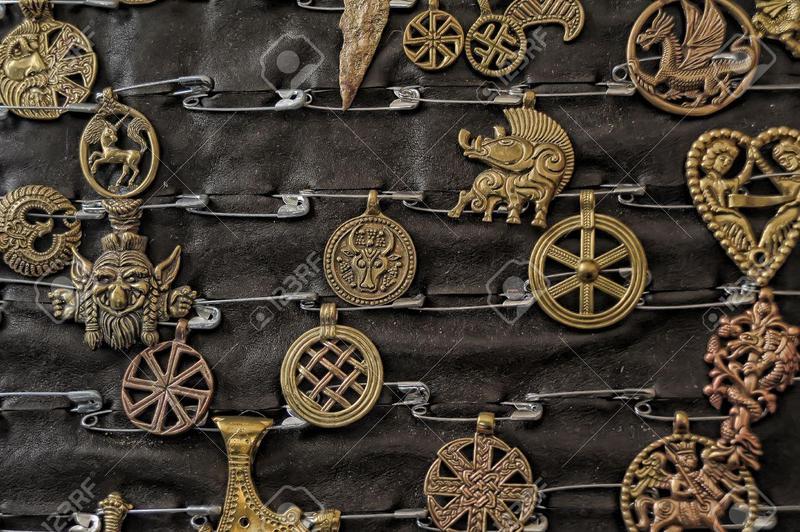Warding Evil and Welcoming Luck: Protective Amulets of the Ancient World
Warding Evil and Welcoming Luck: Protective Amulets of the Ancient World
In the past, human life was vulnerable to disaster; Disease, wars, famine, natural disasters and many other factors could easily claim the lives of individuals. For this reason, people sought all kinds of protection they could get their hands on. This also implied protection of the supernatural sort.Amulets were the most widespread protection of this kind.
People would go to witches, wizards or specialized merchants who knew how to make such objects, and sold them—sometimes at quite a high price. However, people used to pay because protection of their lives was more valuable to them than money. Made out of wood, metal, clay, stone or other materials, many amulets have survived up to the present day. They display a wide range of symbolism which fascinates even the modern man.
Making Magic and Producing Protection
It was believed magic was a source of protection to those who needed it. Thus, a multitude of amulets and talismans appeared, each with different uses. The creation of an amulet was a ritual in itself and an amulet could only be made by an initiate. Each amulet was based on a symbol and among the most well-known amulets are: the Ankh, the Yin-Yang, the pentagram, the Chinese symbol of luck, the nazar, the mystic knot, the all-seeing eye and the Egyptian scarab.
The Ankh (held in the right hand), during the reign of Hatshepsut (1508–1458 BC) (Public Domain)
The symbol of Egyptian sovereigns par excellence, the Ankh is the symbol of eternal life. It was placed in the sarcophagus of all Egyptian pharaohs in order to provide protection and to offer them the chance to live forever in the afterlife. Also, the Ankh was proof of the power and rank of the Pharaoh. Another symbol of Egyptian sovereigns, the scarab symbolized long life. Also, it was believed to possess the power of transformation, and when used as a hieroglyph it meant “to come into being by taking on a given form,” “to be”, and “to become.”
Universal Harmony
The symbol of universal harmony and of the perpetual laws of the universe, the Yin-Yang represents unity in diversity. It was thought that where there is light, there will always be darkness, and where there is darkness, light will also follow. Yin represents the dark, feminine element, while the Yang is the bright, the masculine. From the opposition of the two forces, results universal harmony.
The pentagram has been a very powerful mystic symbol since the dawn of time. It was believed to defend its bearer from all evil and attract good fortune. All these qualities were due to the fact that an element was associated with each corner of the pentagram. Thus, the elements united together attracted beneficial influences.
Good Fortune
The Chinese character for good luck appears as an amulet in many forms. It even now appears on medallions, on buildings, in traditional Chinese calligraphy paintings and in many other examples. It was felt that by wearing this letter, luck was attracted.
Warding Evil
The Nazar or “the blue eye” was thought to have the power to protect against the evil eye and to reject negative energies. This symbol may even now be worn as an amulet, but it can also be seen on airplanes, buildings, cars or in other places.
Originally from Tibet, the mystic knot represented the Samsara, the eternal cycle of reincarnation. Also, it represented unlimited wisdom and the strong connection between knowledge and applied method. A powerful symbol, it was believed to attract the benevolent energies of the ancestors to their descendants.
The all-seeing eye was thought to have the power to provide knowledge. It was said to see and reflect the past, the present, and the future. Because knowledge is power, legend the one who had it could become the most powerful man on earth.
Maneki Neko is a popular cat symbol with its raised paw meant to invite good luck. The higher the paw is in the air, the greater the invited luck. Also, it sometimes holds a Koban, a Japanese coin meant to ensure financial luck. Widely used in Feng Shui, Chinese coins with lucky symbols are believed to attract financial luck. In most cases, they have represented on them a dragon alone, or a dragon and a tiger together, in order to attract the positive energies of these two mythological beings.
Throughout human history a multitude of magical rituals were conducted for different purposes and intentions. Magic rituals led to the appearance of magical objects such as amulets which are still believed to have different warding or welcoming properties, and are thought to be able to help the wearer in various regards. All these have improved man’s life or, at least, they have given him the feeling that he is under the influence of divine protection.
by Ancient Origins
Be the first to post a message!
